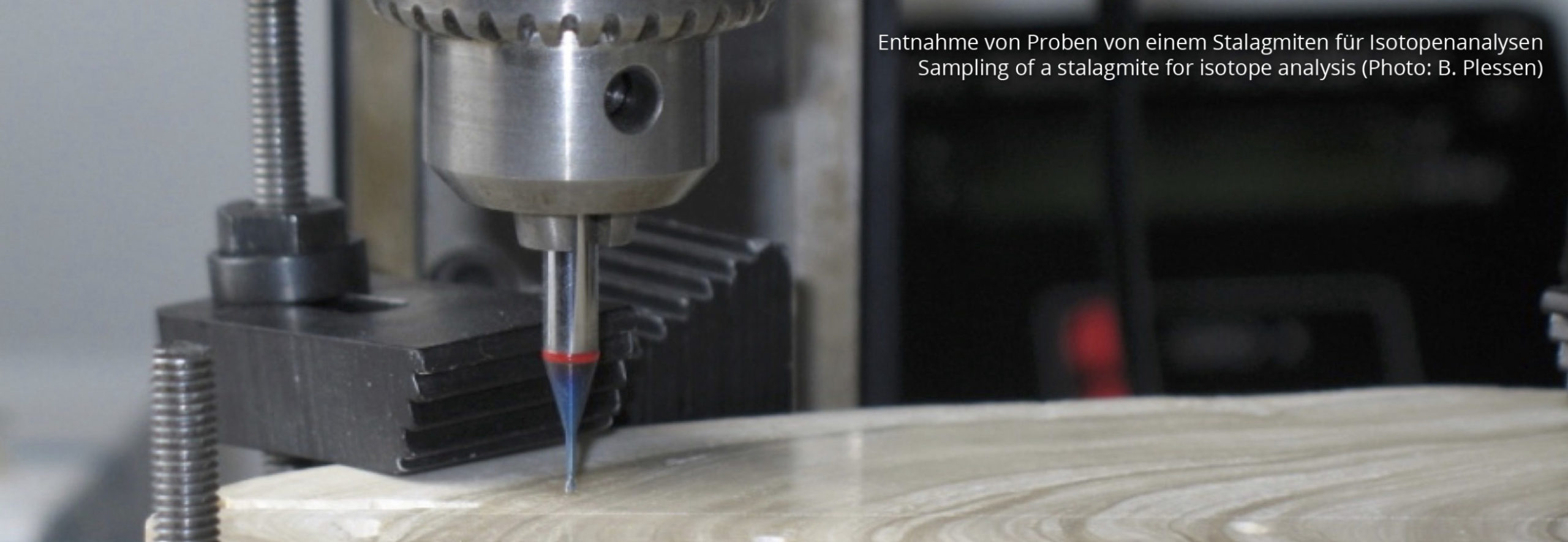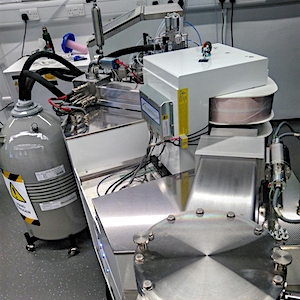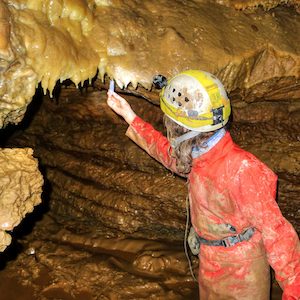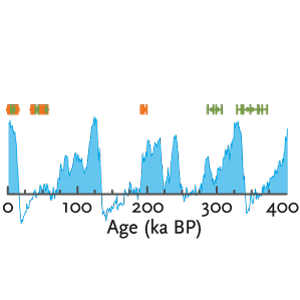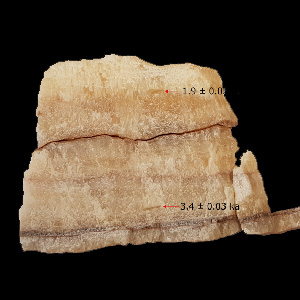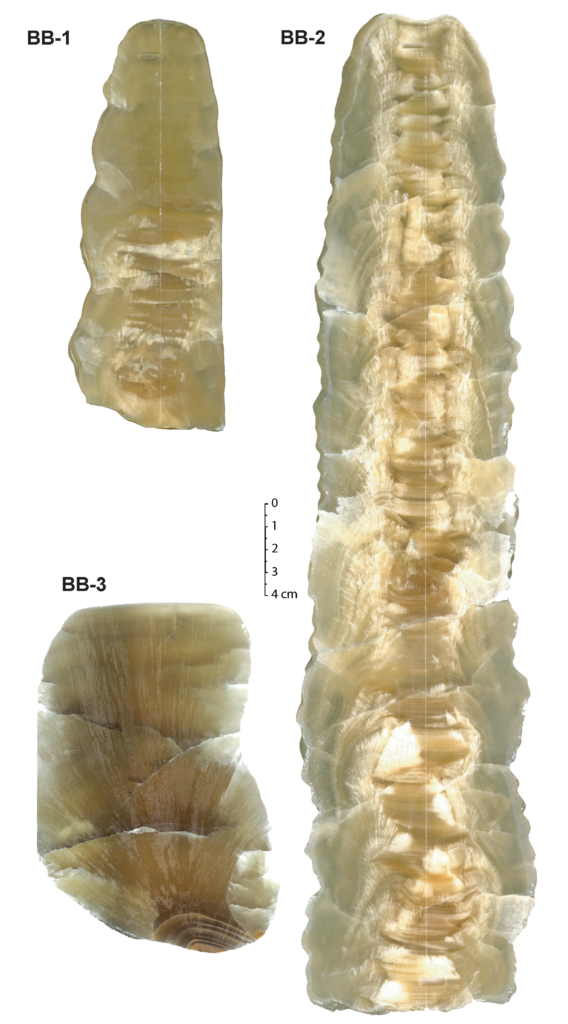Breitenbach, Sebastian F. M.; Marwan, Norbert
Die Bleßberghöhle – ein Glücksfall für die Klimaforschung Book Section
In: Thüringer Höhlenverein, e. V. (Ed.): Nächster Halt: Bleßberghöhle, Suhl, 2022.
@incollection{breitenbach_bbh2022,
title = {Die Bleßberghöhle – ein Glücksfall für die Klimaforschung},
author = {Sebastian F. M. Breitenbach and Norbert Marwan},
editor = {Thüringer Höhlenverein, e. V.},
year = {2022},
date = {2022-02-22},
urldate = {2022-02-22},
booktitle = {Nächster Halt: Bleßberghöhle},
address = {Suhl},
abstract = {Höhlen stellen generell für die Wissenschaft ein wertvolles Archiv dar, aus dem vielfältige und interessante Erkenntnisse gewonnen werden können. So gehören sie inzwischen auch zu den bedeutendsten Klimaarchiven auf dem Festland (See- und Meeressedimente stellen andere wichtige Archive dar). Solange die Höhlensedimente und Sinter ungestört bleiben, können hydrologische und klimatische Bedingungen detailliert aufgezeichnet werden. Die Bleßberghöhle ist in diesem Zusammenhang ein ausgesprochener Glücksfall, da sie über viele Jahrtausende komplett verschlossen war und so vor äußeren Störungen bewahrt wurde. Sie ist in vielen Abschnitten mit verschiedensten Sinterformen geschmückt. Für die Rekonstruktion regionaler Klimaänderungen sind vor allem die Stalagmiten geeignet. Die wissenschaftliche Bearbeitung des aus der Bleßberghöhle gesammelten Materials ist ein langwieriger Prozess und noch lange nicht abgeschlossen. Zum gegenwärtigen Zeitpunkt können aber bereits erste interessante Aussagen gemacht werden, auf die wir hier nach einem kurzen allgemeinen Einblick in verschiedene Aspekte der Paläoklimaforschung eingehen wollen.},
keywords = {},
pubstate = {published},
tppubtype = {incollection}
}
Breitenbach, Sebastian F. M.; Plessen, Birgit; Wenz, Sarah; Leonhardt, Jens; Tjallingii, Rik; Scholz, Denis; Jochum, Klaus-Peter; Marwan, Norbert
A multi-proxy reconstruction of Holocene climate change from Blessberg Cave, Germany Proceedings Article
In: Geophysical Research Abstracts, pp. EGU2016-14213, 2016.
@inproceedings{breitenbach2016,
title = {A multi-proxy reconstruction of Holocene climate change from Blessberg Cave, Germany},
author = {Sebastian F. M. Breitenbach and Birgit Plessen and Sarah Wenz and Jens Leonhardt and Rik Tjallingii and Denis Scholz and Klaus-Peter Jochum and Norbert Marwan},
url = {https://bbh.pik-potsdam.de/wp-content/uploads/2021/05/Breitenbach_poster_EGU_2016.pdf},
year = {2016},
date = {2016-04-01},
booktitle = {Geophysical Research Abstracts},
volume = {18},
pages = {EGU2016-14213},
abstract = {Although Holocene climate dynamics were relatively stable compared to glacial conditions, climatic changes had significant impact on ecosystems and human society on various timescales (Mayewski et al. 2004, Donges et al. 2015, Tan et al. 2015). Precious few high-resolution records on Holocene temperature and precipitation conditions in Central Europe are available (e.g., von Grafenstein et al. 1999, Fohlmeister et al. 2012).
Here we present a speleothem-based reconstruction of past climate dynamics from Blessberg Cave, Thuringia, central Germany. Three calcitic stalagmites were recovered when the cave was discovered during tunneling operations in 2008. Samples BB-1, -2 and -3 were precisely dated by the 230Th/U-method, with errors between 10 and 160 years (2σ). The combined record covers large parts of the Holocene (10 – 0.4 ka BP). δ13C and δ18O were analysed at 100 μm resolution. To gain additional insights in infiltration conditions, Sr/Ca and S/Ca were measured on BB-1 and BB-3 using an Röntgenanalytik Eagle XXL μXRF scanner.
Differences to other central European records (e.g., von Grafenstein et al. 1999, Fohlmeister et al. 2012) suggest complex interaction between multiple factors influencing speleothem δ18O in Blessberg Cave. Furthermore, no clear influence of the North Atlantic Oscillation on our proxies is found. However, a link across the N Atlantic realm is indicated by a centennial-scale correlation between Blessberg δ18O values and minerogenic input into lake SS1220 in Greenland over the last 5 ka (Olsen et al. 2012). In addition, recurrence analysis indicates an imprint of Atlantic Bond events on Blessberg δ18O values (Marwan et al. 2014), corroborating the suggested link with high northern latitudes. Larger runoff into the Greenland lake seems to be associated with lower δ18O, higher δ13C and S/Ca ratios, as well as lower Sr/Ca ratios in Blessberg Cave speleothems. This might be linked to lower local temperature and/or changes in precipitation seasonality. Opposing millennial scale trends with lowering S/Ca ratios and δ13C values but increasing Sr/Ca ratios calls for more than one controlling factor. Most likely, δ13C decreased through the Holocene due to afforestation, which in turn might have increased sulphate retention in the thickening soil cover (Frisia et al. 2005) and limited sulphur flux into the cave. Alternatively, marine sulfur flux could have diminished with winter wind intensities. However, additional data is required to clarify this hypothesis. A positive Sr/Ca trend through the Holocene might result from increasing prior calcite precipitation induced by a negative moisture balance in summer.},
keywords = {},
pubstate = {published},
tppubtype = {inproceedings}
}
Here we present a speleothem-based reconstruction of past climate dynamics from Blessberg Cave, Thuringia, central Germany. Three calcitic stalagmites were recovered when the cave was discovered during tunneling operations in 2008. Samples BB-1, -2 and -3 were precisely dated by the 230Th/UU/Th-Datierung Die U/Th-Datierung ist eine sehr präzise radiometrische Altersbestimmung auf Basis der Uran-Thorium-Zerfallsreihe. Das Uran zerfällt mit bekannten Halbwertszeiten (245.500 Jahre) zum Tochterelement Thorium. Stalagmiten bauen bei ihrem Wachstum (fast) nur das wasserlösliche Uran ein, während das schlecht bewegliche Thorium zum größten Teil im Boden und Epikarst über der Höhle verbleibt. Das kann man nutzen, um die Zeit zu berechnen, die seit der Ausfällung der untersuchten Karbonatprobe vergangen ist. Moderne massenspektrometrische Verfahren erlauben Altersbestimmungen mit der U/Th-Methode bis zu 700.000 Jahren vor Heute.-method, with errors between 10 and 160 years (2σ). The combined record covers large parts of the Holocene (10 – 0.4 ka BPka BP Mit "ka BP" sind "Tausend Jahre vor 1950" gemeint. Das "BP" steht für "before present", was in der Paläoklima-Wissenschaft als 1950 festgelegt wurde. "11.000 ka BP" bedeuted also 11 Tausend Jahre vor 1950, oder unter Verwendung unseres gewohnten Kalenders: 9050 v. Chr.). δ13C and δ18O were analysed at 100 μm resolution. To gain additional insights in infiltration conditions, Sr/Ca and S/Ca were measured on BB-1 and BB-3 using an Röntgenanalytik Eagle XXL μXRF scanner.
Differences to other central European records (e.g., von Grafenstein et al. 1999, Fohlmeister et al. 2012) suggest complex interaction between multiple factors influencing speleothem δ18O in Blessberg Cave. Furthermore, no clear influence of the North Atlantic Oscillation on our proxiesProxy Umwelt- und Klimainformationen aus der Vergangenheit sind nicht direkt verfügbar, weil niemand da war, der diese messen und aufzeichnen konnte. Daher ist man darauf angewiesen, diese Informationen indirekt aus anderen Informationen abzuleiten, wie z. B. Baumringe, das Verhältnis von Sauerstoffisotopen, Spurenelementen, Mächtigkeit von Sedimentschichten usw. Diese Art von Daten nennt man Proxies, was aus dem englischen stammt und „Stellvertreter“ bedeutet. is found. However, a link across the N Atlantic realm is indicated by a centennial-scale correlation between Blessberg δ18O values and minerogenic input into lake SS1220 in Greenland over the last 5 kaka BP Mit "ka BP" sind "Tausend Jahre vor 1950" gemeint. Das "BP" steht für "before present", was in der Paläoklima-Wissenschaft als 1950 festgelegt wurde. "11.000 ka BP" bedeuted also 11 Tausend Jahre vor 1950, oder unter Verwendung unseres gewohnten Kalenders: 9050 v. Chr. (Olsen et al. 2012). In addition, recurrence analysis indicates an imprint of Atlantic Bond events on Blessberg δ18O values (Marwan et al. 2014), corroborating the suggested link with high northern latitudes. Larger runoff into the Greenland lake seems to be associated with lower δ18O, higher δ13C and S/Ca ratios, as well as lower Sr/Ca ratios in Blessberg Cave speleothems. This might be linked to lower local temperature and/or changes in precipitation seasonality. Opposing millennial scale trends with lowering S/Ca ratios and δ13C values but increasing Sr/Ca ratios calls for more than one controlling factor. Most likely, δ13C decreased through the Holocene due to afforestation, which in turn might have increased sulphate retention in the thickening soil cover (Frisia et al. 2005) and limited sulphur flux into the cave. Alternatively, marine sulfur flux could have diminished with winter wind intensities. However, additional data is required to clarify this hypothesis. A positive Sr/Ca trend through the Holocene might result from increasing prior calcite precipitation induced by a negative moisture balance in summer.
The first results of the geochemical analyses of the three stalagmites BB-1 to BB-3 already allow conclusions about the climatic changes of the last 14,000 years. A detailed interpretation can be found in the article Climate zone shift in Central Europe.
